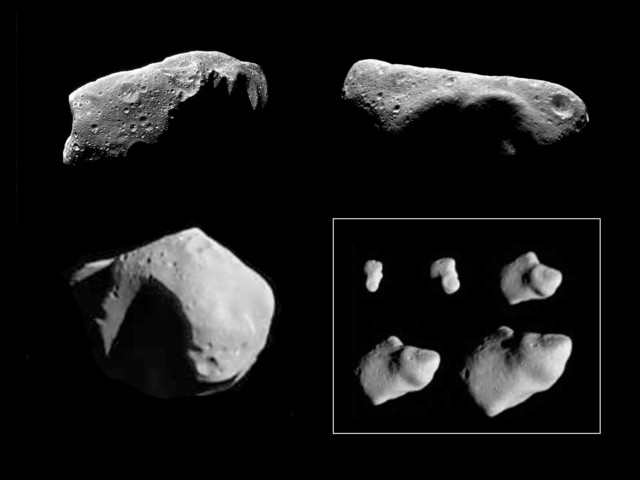
home •
about •
essential guide •
picture of the day •
thunderblogs •
news •
multimedia •
predictions •
products •
get involved •
contact

pic of the day
archive
subject index
abstract
archive
Links:
Society for
Interdisciplinary
Studies
Jul 14, 2005
Asteroids That Should Not Be
Recent pictures of asteroids suggest that the survival of these bodies refutes the popular theory of their formation and history. If the largest craters had been formed by impact, the asteroids would have been shattered.
The popular view of asteroids holds that their history began in the same way as that of planets in their early formative phases, accreting out of a primordial cloud of neutral gas. But while planets continued to accrete matter, the asteroids did not, perhaps because of the gravitational influence on them from the emerging gas giant Jupiter.
It is commonly suggested that asteroids have, by virtue of their interrupted history, preserved a pristine record of the early solar system. A similar belief holds with respect to comets, though most comets are claimed to have formed much farther away from the Sun, in the now legendary Oort cloud.
These speculative notions have been around now for decades, and often science writers forget to distinguish between speculation and fact. Astronomers do not know how asteroids formed. They have guessed at an answer.
One undeniable fact is that recent photographs of these bodies pose severe challenges to popular ideas about asteroids. By comparison with planets and moons, asteroids are trivially weak attractors gravitationally. Furthermore, most of the lesser bodies traveling in their neighborhood would be moving in the same direction. Standard impact theory requires speeds of many thousand of miles per hour.
After their hypothesized formation, how did they acquire such pervasive cratering? They are covered with innumerable small circular craters and a few unnervingly large craters, a feature that virtually all asteroids appear to have in common.
If the impact theory of crater formation were true, observation suggests that each body was struck by a least one rock (some by more than one) of sufficient size and velocity to shatter the body. But none were shattered. The asteroids have not only remained intact, but they show no evidence of cracking or splintering under the stresses.
As new pictures came in, the mystery grew to the point that some astrophysicists began to speculate that perhaps asteroids were formed by an aggregation of lesser rocks.
A similar turn occurred when the standard comet model began to fail. When comets such as Linear broke up, the cometologists could only imagine this happening if they were loose aggregates of separate pieces, or perhaps something as tenuous as “fluff balls”.
But none of our visits to asteroids or to comets have supported such notions. The best pictures suggest rock-solid objects, as can be seen in the images given above. And as far as comets go, by NASA’s own admission the “Deep Impact” on Tempel 1 effectively ended speculation about comets as loose aggregations.
On issues such as this, the electric model of comet and asteroid formation has a distinct advantage. To produce craters of any size, it does not stipulate that one solid body must crash into another. The proposed electrical history of the solar system was punctuated by intensely energetic events and by violent electrical interactions between planets and moons, but the resulting scars did not come from the brute force of collision. Electric arcs can remove material with ease. They have the ability to cut surface depressions, to scoop out material, and to accelerate it into space, leaving behind cleanly cut geologic relief. This ability of the electric arc is why it is used so commonly in electric discharge machining (EDM).
In the photograph of the asteroid Ida, above left, the right side of the asteroid exhibits sharply cut gouges that altered the fundamental shape of the body The same asteroid shows a depression on its westward termination almost as wide as its diameter. Could impacts have achieved these things while leaving no other evidence of disturbance?
Then there is the asteroid Eros as photographed up close and personal by the NEAR spacecraft. On the impact theory, it must have been broadsided more than once, producing craters with diameters equal to the width of the distinctly oblong object.
The asteroid Mathilda revealed equally inconceivable “impacts”. At its closest approach, NEAR flew within 1,200 kilometers of Mathilda. As stated in the report by the Planetary Society:
“The images show a surface covered with craters, some surprisingly large in size. At least five of the craters imaged by NEAR are over 20 kilometers in size. To form craters that large, Mathilda had to be hit by objects almost 2 kilometers in size. It is amazing that such collisions didn't completely break apart the asteroid”.
“Amazing”, yes, but apparently not sufficient to provoke a reconsideration of theory.
To further underscore the enigma, we include on the right below five views of the asteroid Gaspra, taken on Galileo’s approach. If the large craters were caused by impact, then something miraculous occurred to prevent the demolition of the body. Here too the “impacts” on the ends of the object succeeded in creating depressions almost as wide as the diameter of the body itself. But the surrounding terrain was not disturbed.
Tomorrow’s Picture of the Day: Deep Impact Review
EXECUTIVE EDITORS:
David Talbott, Wallace Thornhill
MANAGING EDITOR: Amy Acheson
CONTRIBUTING EDITORS: Mel Acheson, Michael Armstrong, Dwardu Cardona,
Ev Cochrane, C.J. Ransom, Don Scott, Rens van der Sluijs, Ian Tresman
WEBMASTER: Michael Armstrong
Copyright 2005: thunderbolts.info